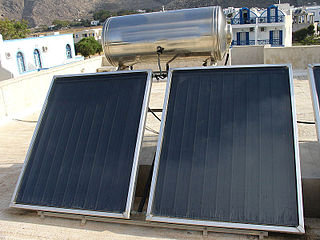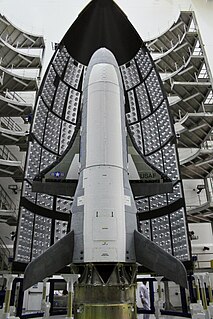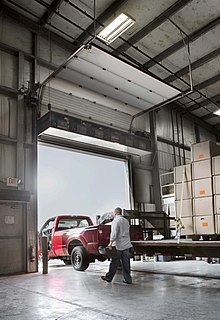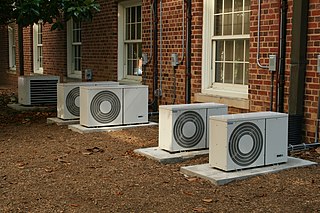
A space suit or spacesuit is a garment worn to keep a human alive in the harsh environment of outer space, vacuum and temperature extremes. Space suits are often worn inside spacecraft as a safety precaution in case of loss of cabin pressure, and are necessary for extravehicular activity (EVA), work done outside spacecraft. Space suits have been worn for such work in Earth orbit, on the surface of the Moon, and en route back to Earth from the Moon. Modern space suits augment the basic pressure garment with a complex system of equipment and environmental systems designed to keep the wearer comfortable, and to minimize the effort required to bend the limbs, resisting a soft pressure garment's natural tendency to stiffen against the vacuum. A self-contained oxygen supply and environmental control system is frequently employed to allow complete freedom of movement, independent of the spacecraft.

Heating, ventilation, and air conditioning (HVAC) is the use of various technologies to control the temperature, humidity, and purity of the air in an enclosed space. Its goal is to provide thermal comfort and acceptable indoor air quality. HVAC system design is a subdiscipline of mechanical engineering, based on the principles of thermodynamics, fluid mechanics, and heat transfer. "Refrigeration" is sometimes added to the field's abbreviation as HVAC&R or HVACR, or "ventilation" is dropped, as in HACR.
The MIT Lincoln Laboratory, located in Lexington, Massachusetts, is a United States Department of Defense federally funded research and development center chartered to apply advanced technology to problems of national security. Research and development activities focus on long-term technology development as well as rapid system prototyping and demonstration. Its core competencies are in sensors, integrated sensing, signal processing for information extraction, decision-making support, and communications. These efforts are aligned within ten mission areas. The laboratory also maintains several field sites around the world.

Aviation Week & Space Technology, often abbreviated Aviation Week or AW&ST, is the flagship magazine of the Aviation Week Network. The weekly magazine is available in print and online, reporting on the aerospace, defense and aviation industries, with a core focus on aerospace technology. It has a reputation for its contacts inside the United States military and industry organizations.

The Air Force Research Laboratory (AFRL) is a scientific research organization operated by the United States Air Force Materiel Command dedicated to leading the discovery, development, and integration of aerospace warfighting technologies, planning and executing the Air Force science and technology program, and providing warfighting capabilities to United States air, space, and cyberspace forces. It controls the entire Air Force science and technology research budget which was $2.4 billion in 2006.

A solar thermal collector collects heat by absorbing sunlight. The term "solar collector" commonly refers to a device for solar hot water heating, but may refer to large power generating installations such as solar parabolic troughs and solar towers or non water heating devices such as solar air heaters.

The Boeing X-37, also known as the Orbital Test Vehicle (OTV), is a reusable robotic spacecraft. It is boosted into space by a launch vehicle, then re-enters Earth's atmosphere and lands as a spaceplane. The X-37 is operated by the United States Space Force, and was previously operated by Air Force Space Command until 2019 for orbital spaceflight missions intended to demonstrate reusable space technologies. It is a 120-percent-scaled derivative of the earlier Boeing X-40. The X-37 began as a NASA project in 1999, before being transferred to the United States Department of Defense in 2004.

An air door or air curtain is a device used to prevent air, contaminants, or flying insects from moving from one open space to another. The most common implementation is a downward-facing blower fan mounted over an entrance to a building, or over an opening between two spaces conditioned at different temperatures.

Air conditioning, often abbreviated as A/C or AC, is the process of removing heat and controlling the humidity of air in an enclosed space to achieve a more comfortable interior environment by use of powered "air conditioners" or a variety of other methods, including passive cooling and ventilative cooling. Air conditioning is a member of a family of systems and techniques that provide heating, ventilation, and air conditioning (HVAC).

Reaction Engines Limited is a British aerospace manufacturer based in Oxfordshire, England.

Passive ventilation is the process of supplying air to and removing air from an indoor space without using mechanical systems. It refers to the flow of external air to an indoor space as a result of pressure differences arising from natural forces.

Cargo spacecraft are robotic spacecraft that are designed to carry cargo, possibly to support space stations' operation by transporting food, propellant and other supplies. This is different from a space probe, whose missions are to conduct scientific investigations.
Space Foundation is an American nonprofit organization whose mission is to advocate for all sectors of the global space industry through space awareness activities, educational programs, and major industry events. It was founded in 1983.

Solar air heating is a solar thermal technology in which the energy from the sun, insolation, is captured by an absorbing medium and used to heat air. Solar air heating is a renewable energy heating technology used to heat or condition air for buildings or process heat applications. It is typically the most cost-effective out of all the solar technologies, especially in commercial and industrial applications, and it addresses the largest usage of building energy in heating climates, which is space heating and industrial process heating.

The G. Wayne Clough Undergraduate Learning Commons, commonly referred to by its acronym CULC, is an academic building on the main campus of the Georgia Institute of Technology. The five-story, 220,000 sq ft (20,000 m2) building houses classrooms, science laboratories, academic services, commons areas, and is managed by and connected to the Georgia Tech Library. Named in honor of President Emeritus G. Wayne Clough, the Clough Commons cost $85 million and opened in the fall of 2011.

Thermal destratification is the process of mixing the internal air in a building to eliminate stratified layers and achieve temperature equalization throughout the building envelope.

The Chief Scientist of the Air Force is the most senior science & technology representative in the United States Department of the Air Force. The current Chief Scientist of the United States Air Force is Victoria Coleman, sworn in on April 6, 2021.

Space nursing is a specialty that works with astronauts to determine medical fitness for their missions, equips NASA team members to handle emergencies in orbit and researches the effects of space travel on the human body. The career got its start during the space race of the 1960s and has grown—both in terms of number of people in the field and knowledge base—ever since. Research conducted by medical professionals in the aeronautics field has led to many breakthroughs in disease treatment of earthbound patients and the discipline continually develops new technology to make space medicine more effective.

Cheyenne Mountain Space Force Station (CMSFS) is located on Cheyenne Mountain on the Front Range of the Rocky Mountains in unincorporated El Paso County, Colorado, next to Colorado Springs, The Cheyenne Mountain Complex, an underground facility on Cheyenne Mountain SFS, was first built for the North American Aerospace Defense Command (NORAD) Combat Operations Center, though NORAD moved day-to-day operations to its headquarters on Peterson AFB in 2006. However, day-to-day operations were moved back in 2011 after a major overhaul and renovation. The location now supports U.S. Space Command's Missile Warning Center, other strategic warning and survivable capabilities, and provides a ready alternative operating location for NORAD's command center.

Christopher Sembroski is an American data engineer, Air Force veteran, and commercial astronaut, currently living in Everett, Washington, United States. He was joined by billionaire Jared Isaacman on the Inspiration4 mission to orbit.

















